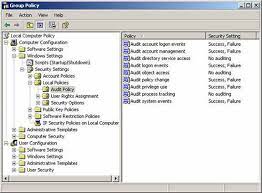The Importance of Active Directory Audit
Active Directory, a crucial component of many organisations’ IT infrastructure, serves as a centralised database that stores and manages network resources. With the increasing number of cyber threats and regulatory requirements, maintaining the security and integrity of Active Directory has become paramount.
Conducting regular audits of Active Directory is essential to ensure that only authorised users have access to sensitive data and resources. An active directory audit involves reviewing logs, monitoring user activities, detecting anomalies, and verifying compliance with security policies.
By performing an active directory audit, organisations can:
- Identify and mitigate security vulnerabilities: Auditing helps in identifying weak points in the system that could be exploited by malicious actors. By addressing these vulnerabilities proactively, organisations can enhance their overall security posture.
- Monitor user activities: Auditing allows organisations to track user logins, file access, permission changes, and other critical events. This visibility helps in detecting unauthorised actions or suspicious behaviour within the network.
- Ensure compliance with regulations: Many industries have stringent data protection regulations that require organisations to maintain proper access controls and auditing mechanisms. Regular audits help in demonstrating compliance with these regulations.
- Improve incident response: In the event of a security incident or data breach, an active directory audit can provide valuable insights into the root cause and extent of the damage. This information is crucial for effective incident response and remediation.
In conclusion, active directory audit is not just a best practice but a necessity for modern organisations looking to safeguard their digital assets and maintain regulatory compliance. By investing in regular audits and leveraging advanced auditing tools, businesses can stay one step ahead of cyber threats and protect their most valuable information.
Five Essential Tips for Effective Active Directory Auditing
- Enable auditing for important events like logon/logoff, account management, and object access.
- Regularly review audit logs to detect any suspicious activities or unauthorized access.
- Restrict access to audit logs to only authorized personnel to maintain data integrity.
- Implement strong password policies and regularly monitor changes in user accounts and group memberships.
- Consider using third-party tools for advanced monitoring and reporting capabilities.
Enable auditing for important events like logon/logoff, account management, and object access.
To enhance the security and monitoring capabilities of your Active Directory environment, it is crucial to enable auditing for key events such as logon/logoff activities, account management changes, and object access. By configuring auditing settings to track these critical events, organisations can gain valuable insights into user interactions with the system, detect suspicious behaviour or unauthorised access attempts, and maintain a comprehensive audit trail for compliance purposes. Enabling auditing for these important events is a proactive measure that strengthens the overall security posture of Active Directory and helps in identifying and responding to potential security incidents effectively.
Regularly review audit logs to detect any suspicious activities or unauthorized access.
Regularly reviewing audit logs is a critical aspect of an effective Active Directory audit strategy. By diligently monitoring these logs, organisations can swiftly detect any signs of suspicious activities or unauthorised access within their network. This proactive approach not only helps in identifying potential security breaches at an early stage but also enables prompt mitigation actions to be taken to safeguard sensitive data and resources. Maintaining a vigilant eye on audit logs is key to maintaining the integrity and security of the Active Directory environment.
Restrict access to audit logs to only authorized personnel to maintain data integrity.
To maintain the integrity of data in Active Directory audits, it is crucial to restrict access to audit logs to authorised personnel only. By limiting access to individuals with the necessary permissions and training, organisations can ensure that audit logs remain secure and tamper-proof. This measure not only safeguards sensitive information from unauthorised viewing or modification but also enhances accountability and transparency within the auditing process. Controlling access to audit logs helps in upholding data integrity standards and strengthens overall cybersecurity practices in the organisation.
Implement strong password policies and regularly monitor changes in user accounts and group memberships.
Implementing strong password policies and regularly monitoring changes in user accounts and group memberships are critical aspects of an effective Active Directory audit strategy. Strong password policies help prevent unauthorised access by ensuring that users create complex and secure passwords. Regularly monitoring changes in user accounts and group memberships allows organisations to quickly detect any suspicious activity or unauthorised modifications, enabling prompt action to mitigate potential security risks. By prioritising these measures, businesses can enhance the overall security of their Active Directory environment and proactively safeguard against potential threats.
Consider using third-party tools for advanced monitoring and reporting capabilities.
When conducting an active directory audit, it is advisable to consider utilising third-party tools to enhance monitoring and reporting capabilities. Third-party tools often offer advanced features and functionalities that can provide deeper insights into user activities, security events, and compliance status within the Active Directory environment. These tools can streamline the auditing process, automate tasks, and generate comprehensive reports that help organisations identify risks, track changes effectively, and ensure regulatory compliance more efficiently. By incorporating third-party tools into the audit process, businesses can elevate their security posture and gain a more holistic view of their IT infrastructure’s health.

